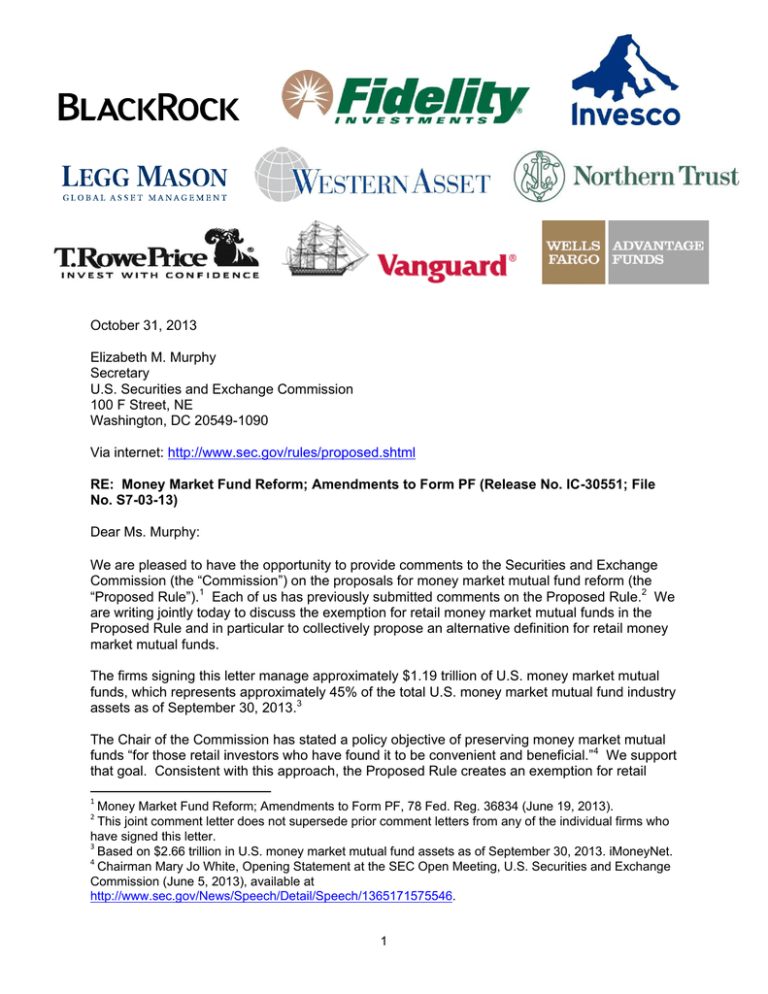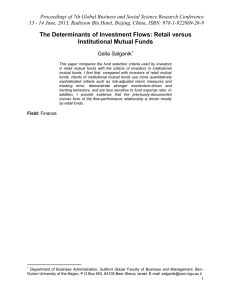October 31, 2013 Elizabeth M. Murphy Secretary
advertisement

October 31, 2013 Elizabeth M. Murphy Secretary U.S. Securities and Exchange Commission 100 F Street, NE Washington, DC 20549-1090 Via internet: http://www.sec.gov/rules/proposed.shtml RE: Money Market Fund Reform; Amendments to Form PF (Release No. IC-30551; File No. S7-03-13) Dear Ms. Murphy: We are pleased to have the opportunity to provide comments to the Securities and Exchange Commission (the “Commission”) on the proposals for money market mutual fund reform (the “Proposed Rule”).1 Each of us has previously submitted comments on the Proposed Rule.2 We are writing jointly today to discuss the exemption for retail money market mutual funds in the Proposed Rule and in particular to collectively propose an alternative definition for retail money market mutual funds. The firms signing this letter manage approximately $1.19 trillion of U.S. money market mutual funds, which represents approximately 45% of the total U.S. money market mutual fund industry assets as of September 30, 2013.3 The Chair of the Commission has stated a policy objective of preserving money market mutual funds “for those retail investors who have found it to be convenient and beneficial.”4 We support that goal. Consistent with this approach, the Proposed Rule creates an exemption for retail 1 Money Market Fund Reform; Amendments to Form PF, 78 Fed. Reg. 36834 (June 19, 2013). This joint comment letter does not supersede prior comment letters from any of the individual firms who have signed this letter. 3 Based on $2.66 trillion in U.S. money market mutual fund assets as of September 30, 2013. iMoneyNet. 4 Chairman Mary Jo White, Opening Statement at the SEC Open Meeting, U.S. Securities and Exchange Commission (June 5, 2013), available at http://www.sec.gov/News/Speech/Detail/Speech/1365171575546. 2 1 money market funds from the floating NAV requirement. The Commission has proposed to define a retail fund as a fund that “does not permit any shareholder of record to redeem more than $1,000,000 of redeemable securities on any one business day.”5 As previously stated in our comment letters, this proposed daily redemption limit would be burdensome to implement for both funds and third party intermediaries, resulting in significant costs and operational complexity. More importantly, investors do not want a continuous limitation on their ability to redeem shares. Based on our collective experience and technical expertise managing money market mutual funds, we believe that there is a simpler and more cost effective way to achieve the Commission’s goal of providing an exemption for retail investors.6 We propose an alternative approach in which a retail money market mutual fund is defined under Rule 2a-7 under the Investment Company Act of 1940, as amended, as follows: Retail Fund means a fund that limits beneficial ownership interest to natural persons.7 This definition would include individuals investing in money market mutual funds through individual accounts, retirement accounts, college savings plans, health savings plans and ordinary trusts.8 After reviewing the available information that we have on the types of investors holding shares of our money market mutual funds, we believe that including individual accounts, retirement accounts, college savings plans, health savings plans and ordinary trusts would be consistent with our existing “retail” investor base as well as other types of accounts for the benefit of natural persons which may arise in the future. Our proposed definition would not permit investments by accounts established by businesses, including small businesses, defined benefit plans, endowments or similar accounts where natural persons do not represent the beneficial ownership interest of those accounts. As a means of ensuring compliance with this rule, each retail fund would be required to disclose in its prospectus that it limits investments to accounts where natural persons have the beneficial ownership interest. Fund advisers would adopt policies and procedures reasonably designed to ensure compliance with that limitation. Funds could comply by: 5 See, supra note 1, at 37001. Although the Commission only proposed an exemption for retail funds under Alternative 1, we believe that the retail definition proposed herein should create an exemption whether the Commission adopts either Alternative 1 or Alternative 2. 7 The term “natural person” is not defined under the Investment Company Act of 1940 (“ICA”) or any of the rules promulgated thereunder, although Section 2(a)(28) of the ICA does define “person” as “a natural person or a company.” We note that banking regulations provide that “natural person means a human being.” 12 CFR 330.1(l). That definition reflects the common understanding of the words “natural person” which we believe is reflected in the ICA. 8 Retirement accounts would include: a participant directed “defined contribution plan” within the meaning of Section 3(34) of the Employee Retirement Income Security Act (“ERISA”); an individual retirement account within the meaning of Section 408 or 408A of the Internal Revenue Code (“IRC”); a simplified employee pension arrangement under Section 408(k) of the IRC; a simple retirement account under Section 408(p) of the IRC; a custodial account under Section 403(b)(7) of the IRC; a deferred compensation plan for government or tax-exempt organization employees under Section 457 of the IRC; a Keogh (HR 10) plan qualified under Section 401(a) of the IRC; and an Archer MSA established under Section 220(d) of the IRC. A college saving plan would be those established under Section 529 of the IRC and a health savings account would be those established under Section 223 of the IRC. A personal trust would be an “ordinary trust” within the meaning of Section 7701 of the IRC. 6 2 directly confirming the individual’s ownership, such as when the customer provides a social security number to the fund adviser, when opening a taxable or tax-deferred account through the adviser’s transfer agent or brokerage division; indirectly confirming the individual’s ownership interest, such as when a social security number is provided to the fund adviser in connection with recordkeeping for a retirement plan or a trust account is opened with information regarding the individual beneficiaries; or relying on periodic representations of a third party intermediary to confirm the individual’s ownership interest, such as when a fund is providing investment only services to a retirement plan or an omnibus provider is unable or unwilling to share information that would identify the individual. With respect to third party intermediaries, fund advisers could rely upon contractual arrangements that require such intermediaries to abide by all fund policies. Other advisers may choose to require periodic certifications from intermediaries that they have policies in place that are reasonably designed to ensure that only natural persons invest in a retail fund. Defining retail funds in this way offers several advantages. First, we believe this definition achieves the goal of preserving the money market mutual fund product for those individuals whose redemption activity does not threaten a fund’s liquidity or stability. We think this definition encompasses the large majority of individual investors who use retail accounts today. Often, in each of these accounts, individuals would be responsible for making the decision to leave a fund during a time of crisis rather than an institutional decision maker.9 Our experience has shown that in times of crisis, these individuals are less likely to redeem en masse. Additionally, shares of such a retail fund would be more widely dispersed among a greater number of shareholders than the institutional funds that experienced large outflows during the financial crisis in 2008. The graph below illustrates how a retail fund under this proposed definition is likely to perform during a time of market stress. Starting on the last business day before Lehman Brothers filed for bankruptcy, the graph shows the cumulative percentage change in assets for three Fidelity retail prime funds and one Fidelity institutional prime fund. Listed next to each fund is the percentage of assets that were held by natural persons.10 Retail Fund A was offered exclusively as an investment option in retirement plans. Note that this fund experienced inflows, not outflows, during the financial crisis as investors reallocated out of equity funds and into money market mutual funds. Retail Fund B had a much broader base of shareholder types because it served as a core (or sweep) cash option for individual retirement accounts and brokerage customers settling trades. Retail Fund C was offered exclusively as a non-core (or non-sweep 9 We acknowledge that with respect to the “defined contribution plans” within the meaning of Section 3(34) of ERISA, the plan sponsor can eliminate or change an investment option (including the money market mutual fund option) and there is no requirement that the plan sponsor provide notice of the change. However, to obtain the benefit of the fiduciary safe harbor in Section 404(c) of ERISA, the plan sponsor must generally provide 30 days’ notice of the change. It can be expected that plan sponsors will provide such notice both to obtain fiduciary protection and for operational reasons (recordkeeping changes take time). We note that as a technical matter a similar action might be able to be taken in other retirement arrangements as well, but the likelihood of such an action is very small. 10 For this purpose, we relied upon social security numbers that were provided either directly to Fidelity or by an intermediary to determine the percentage of the fund’s assets beneficially owned by natural persons. The natural person percentage listed for each fund is as of June 30, 2013. Although the shareholder data from 2008 is not available, there have been no significant changes in the features, offering or distribution of any of these funds since 2008. As a result, Fidelity believes that the percentages shown are reliable indicators of the retail shareholder base for each fund over time. 3 position) investment option for retail customers, retirement plans and individuals who invested primarily through financial advisers or banks. Institutional Fund D had primarily corporate and other institutional shareholders. Despite the extreme market stress at the time, all three retail fund types showed minimal shareholder redemption activity, especially as compared to many institutional prime funds. Percent of Fund Owned By Natural Persons: Net Flows in Selected Fidelity Prime Funds During Fall 2008 10% Cumulative Net Flows as Percent of Initial Assets 97% Retail Fund A 93% 0% Retail Fund B 83% -10% Retail Fund C -20% -30% -40% 3% -50% Institutional Fund D 24-Oct-08 17-Oct-08 10-Oct-08 3-Oct-08 26-Sep-08 19-Sep-08 12-Sep-08 -60% Second, this definition provides a front-end qualifying test and eliminates the need for costly programming and ongoing monitoring by a fund adviser or an intermediary. Under our proposed definition, intermediaries and/or fund advisers would need to verify the nature of the investor only once. This would reduce the operational complexity associated with the proposed definition requiring ongoing monitoring of redemptions. Third, this definition uses data that fund advisers and intermediaries already generally collect from their clients under the “know your customer” practices and anti-money laundering laws. During the account opening process, fund sponsors and intermediaries should be able to easily identify if a client satisfies the definition. This definition will require some refinements to existing systems, which are significantly less costly than building a new system for tracking and aggregating daily shareholder redemption activity. Consequently, fund advisers and intermediaries should not incur significant additional costs that might ultimately be passed along to money market mutual fund investors. 4 * * * * * We thank the Commission for giving us the opportunity to address this important proposed exemption. We welcome the opportunity to further discuss with you the proposed retail definition contained in this letter. Sincerely, BlackRock, Inc. Fidelity Investments Invesco Ltd. Legg Mason & Co, LLC and Western Asset Management Company Northern Trust Corporation T. Rowe Price Associates, Inc. Vanguard Wells Fargo Funds Management, LLC cc: The Honorable Mary Jo White Chair U.S. Securities and Exchange Commission The Honorable Luis A. Aguilar Commissioner U.S. Securities and Exchange Commission The Honorable Daniel M. Gallagher Commissioner U.S. Securities and Exchange Commission The Honorable Michael Piwowar Commissioner U.S. Securities and Exchange Commission 5 The Honorable Kara M. Stein Commissioner U.S. Securities and Exchange Commission Norman B. Champ, III Director Division of Investment Management U.S. Securities and Exchange Commission 6




